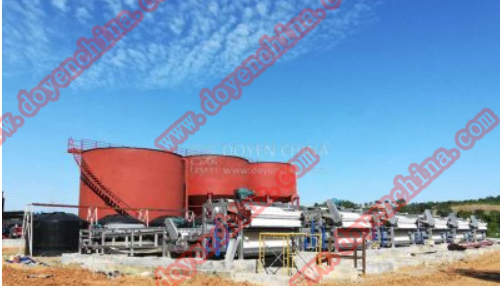

Tel:
+86-757-8633-0278
Email:doyen@doyenchina.com
Fax:+86-757-86287390
Address:Room 201, Building No. 24, Yicui Rose Garden, No. 2, Jihua 7 Road, Chancheng District, Foshan City, Guangdong Province, China 528000.
To understand the method of sand washing wastewater treatment, we must first know what is sand washing wastewater and what are its main ingredients. Only by knowing these can we carry out targeted treatment. Next, let’s listen to the introduction of the sand washing wastewater treatment manufacturer, Shanghai Zhongrui.
1. Current status of sand washing wastewater
Sand washing waste water refers to the waste water produced in the production process of washed sand and stone production enterprises. Sand and gravel is one of the basic materials for construction. With the increasing domestic demand for sand and gravel, natural sand is facing the pressure of resource reduction and environmental protection. As an important source of construction sand, washed sand will enter the building materials market. Washed sand can be widely used in concrete, mortar and products. It has increasingly shown good market prospects in modern construction projects. The gradual replacement of natural sand in quality and quantity is one of the signs that the artificial sand production line has entered a new era of development.

2. Characteristics of sand washing wastewater
The main pollution factor suspended matter of sand washing wastewater, and the concentration of the suspended matter is about 3000mg/L, forming a large amount of mud water. The characteristics of the mud depend on its composition and are related to the local geological conditions. The general characteristics are that the mud has an earthy yellow appearance, is uniform and viscous, is static for a long time without stratification, and has a specific gravity between 1.20 and 1.46 (the proportion of yellow sand is 1.6) ; Mud content 20%-30%, PH value: 6-7. Before the comprehensive treatment of waste water, the annual production of waste water is 80,000 tons (calculated by one mill) based on 8 hours of production per day, 25 days of production per month, and 10 months of production per year. These wastewater contains about 8,000 tons of suspended solids. If the production wastewater is not treated in a timely and effective manner, it will not only waste a lot of water resources, pollute the water quality, affect road traffic, affect the normal production and life of nearby residents, and increase disharmony factors in society.

3. Treatment method of sand washing wastewater
The treatment of sand washing wastewater is the separation of mud and water, which is separated by physical methods. Since the sand washing wastewater contains a large amount of silt, first use the method of natural sedimentation in the primary sedimentation tank to settle the fine sand, and then control to enter the dosing The solid content of the flocculation link is to achieve the purpose of reducing the cost and investment of the medicament, and then by adding flocculants to form particle precipitation, the supernatant liquid enters the clean water tank for reuse, the lower sludge enters the sludge dehydration equipment, and the mud cake is transported and disposed of.
In order to solve the sludge discharge and the recycling of water resources in the mine water sand washing process, the sludge treatment water circulation system has more practical experience in sewage treatment, and its design related schemes have been implemented in many enterprises. And received unanimous praise from the companies used.

Doyen specializes in providing belt press equipment for the Southeast Asian market. Welcome to visit our workshop and formulate a more scientific plan based on the actual situation of your company. Welcome to visit joyce@doyenchina.com or visit https://www.doyenchina.com.
Feb-22-2021
admin

 +86-757-8633-0278
+86-757-8633-0278 doyen@doyenchina.com
doyen@doyenchina.com Sitemap
Sitemap